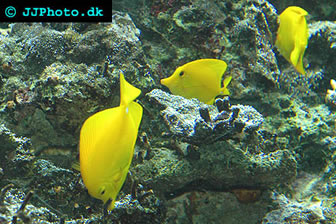Yellow Tang
Zebrasoma flavescens
Zebrasoma flavescens is known under several different names in English, such as Yellow tang, Yellow sailfin tang, Lemon sailfin, and Somber surgeonfish.
Zebrasoma flavescens has not been evaluated for the IUCN Red List of Threatened Species.
Geographical range, habitat and habits
The Yellow tang inhabits the Pacific Ocean and might also live off the coast of Florida in the Western Central Atlantic. It is considered native to the following countries/states/regions: Caroline Island, Guam, Hawaii, Hong Kong, Japan, Johnston Island, Marshall Islands, Micronesia, N Marianas, Ogasawara Islands, Palua, Philippines, Ryukyu Islands, Taiwan, Vietnam, and Wake Island. The geographical limits of the Yellow tang are 30°N to 8°N, and 127°e to 79°w.
The Yellow tang is found in areas of lagoons and seaward reefs with prolific coral growth. It can be encountered from below the surge zone; its dept range is 2-46 meters / 7-150 feet. This fish lives alone or form loose groups.
Size and appearance
The largest scientifically measured Yellow tang was 20.0 cm / 7.9 in.
Just as the common name suggests, the Yellow tang is brightly yellow. This fish has a very deep body with a moderately protruding mouth and a small mouth. Juveniles have 12 upper and 14 lower teeth, while adults have 18 upper and 22 lower teeth.
Yellow tang care
It is not advisable to house the Yellow tang in an aquarium smaller than 60 gallons / 225 litres, because this fish needs plenty of space to swim around in as well as good hiding spots to seek shelter in. Include a lot of live rock in the set-up to promote algae growth. Acropolis coral skeletons are known to be appreciated.
Yellow tangs are generally peaceful creatures but combining them with each other is risky, especially if the fishes are of similar size. Housing this species with other tangs will also increase the risk of violence in the aquarium, particularly if they belong to the same genus.
If the Yellow tang becomes disgruntled or provoked in the aquarium is may shake its sharp spine to scare off other fish but it will rarely resort to actual violence.
The Yellow tang is not considered reef safe since it may nibble at corals.
Strong water movements and a really high oxygen level are strongly recommended when housing Yellow tang. Keep the water temperature in the 75-82° F / 24-28° C range, the pH-value between 8.0 and 8.4, and the specific gravity at 1.020-1.025.
Feeding Yellow tang
In the wild, the Yellow tang feeds primarily on filamentous algae but will also ingest other materials, such as fish eggs and small invertebrates that live among the algae.
It is important to provide the Yellow tang with a varied diet in the aquarium to ensure optimal health. You can for instance use high-quality flakes or pellets suitable for marine algaevores as a base and supplement with boiled vegetables and dried and fresh algae. Algae products can often be found in shops specialized in oriental food. The fish will also need occasional servings of meaty foods.
Breeding Yellow tang
Group spawning and pair-spawning by territorial males that court passing females have been observed in the wild.
We do not have any reports of Yellow tang breeding in aquariums.
Surgeonfish - Tang Articles:
Achilles Surgeonfish – Acanthurus achilles
Atlantic Blue Tang – Acanthurus coeruleus
Blue Hippo Tang – Paracanthurus hepatus
Chevron Tang – Ctenochaetus hawaiiensis
Clown Surgeonfish – Acanthurus lineatus
Convict Surgeonfish – Acanthurus triostegus
Desjardinii Tang – Zebrasoma desjardinii
Kole Tang – Ctenochaetus strigosus
Mimic Surgeonfish – Acanthurus pyroferus
Naso Tang – Naso lituratus
Orangeshoulder Surgeonfish – Acanthurus olivaceus
Powder Blue Tang – Acanthurus leucosternon
Powder Brown Tang – Acanthurus japonica
Purple Tang – Zebrasoma xanthurum
Sailfin Tang – Zebrasoma veliferum
Scopas Tang – Zebrasoma scopas
Whitecheek Surgeonfish – Acanthurus nigricans

